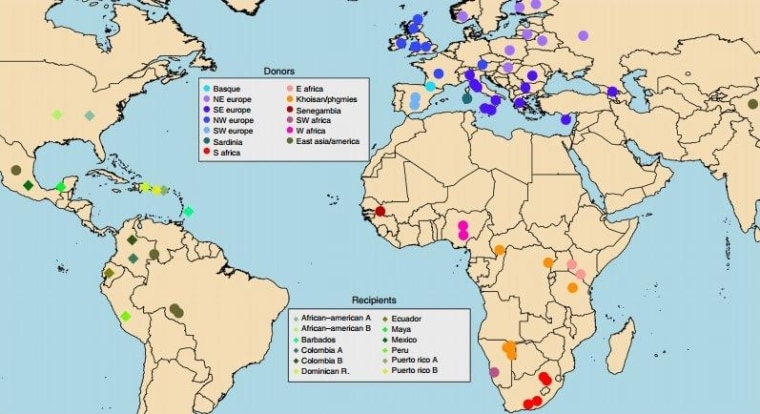Scientists have traced the history of European and African migration to the Americas — not by looking in the history books, but by running genetic information from 4,000 individuals around the world through a high-resolution analysis.
The analysis confirms the historical record, but highlights a few twists that previous genetic methods might have missed — for example, the intermixing of Basque settlers with the Maya and other native populations in current-day Mexico, Central and South America, or the varying genetic contribution from African slaves to populations in North America and the Caribbean.
"We found that the genetic profile of Americans is much more complex than previously thought," Oxford University geneticist Cristian Capelli said in a news release. Capelli is the senior author of a paper about the project published Tuesday in the open-access journal Nature Communications.
Capelli and his colleagues say the technique could be used to untangle the genetic roots of a wide array of mixed populations. The researchers assembled a set of genetic data from 3,960 individuals representing 64 ethnic groups. Then they relied on a computer to sort out which clusters belonged together, on the basis of strings of DNA code known as single-nucleotide polymorphisms, or SNPs ("snips").
The genetic clusters generally paralleled the geographic distributions, with some exceptions. For example, a couple of individuals from France were genetically grouped with Spaniards, while people from Sardinia represented a group apart from mainland Italians.
The same clustering process was used to classify populations in the Americas, and then the computer determined statistically which "donor" populations in Europe, Africa and Asia contributed to the "recipient" populations in the Americas.
Here are some of the key findings:
- Basques from Spain and France provided a small contribution to current-day populations from Mexico to South America. That's is in line with historical accounts of Basque immigration to the Americas, and particularly to Mexico, Cuba, Chile, Peru and Colombia during the 16th and 17th centuries.
- South Italy and Sicily made a significant genetic contribution to populations in Colombia and Puerto Rico. That's consistent with accounts of Italian emigration to those areas in the late 19th and early 20th century, but this study marks the first time the genetic fingerprints of that migration have been seen so clearly.
- Most of the European contribution to Latino populations in the Americas comes from Spain, as would be expected, while the biggest European influence on African-Americans and people from Barbados comes from Britain. Compared to South Americans, people from Barbados and other Caribbean countries had a larger contribution from Africa.
- The biggest African contribution to the Americas came from the ancestors of the modern-day Yoruba people of West Africa, reflecting the pattern of slave trade that started in the 16th century. However, other groups from Senegal and Mozambique contributed as well — which is consistent with the history of slavery in Spanish America.
- One of the U.S. African-American groups showed a large French contribution, in line with the history of French immigration to Louisiana.
"We can see the huge genetic impact that the slave trade had on American populations, and our data match historical records," said a co-author of the study, Garrett Hellenthal of the University of College London Genetics Institute.
Capelli said the results show "just how powerful a genetic approach can be when it comes to uncovering hidden patterns of ancestry." He said the researchers plan to use the technique to untangle the ancestral roots of other mixed populations, such as those found in Brazil.

The technique could have wider applications as well, Capelli told NBC News in an email.
"The knowledge of the detailed genetic structure of populations has implications for epidemiological studies, disease susceptibility and drug metabolism," he said, "as genetic variants involved in all these aspects are known to vary across population within the same continent."
Different populations tend to have different medical profiles, "and this would be reflected in the populations that received DNA from such sources," Capelli said.
The principal author of "Unraveling the Hidden Ancestry of American Admixed Populations" is Francesco Montinaro, a researcher at Oxford and the Catholic University in Rome. In addition to Capelli and Hellenthal, other authors include George Busby, Vincenzo Pascali and Simon Myers.